Commercial Salmon Fisheries
Southeast Alaska & Yakutat Research: Chum Salmon

Figure 1. — Click for more Info
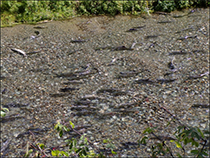
Figure 2. — Click for more Info

Figure 3. — Click for more Info
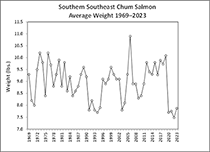
Figure 4. — Click for more Info

Figure 5. — Click for more Info

Figure 6. — Click for more Info
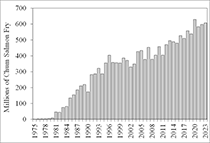
Figure 7. — Click for more Info
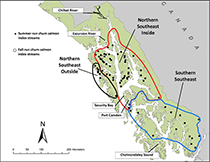
Figure 8. — Click for more Info

Figure 9. — Click for more Info
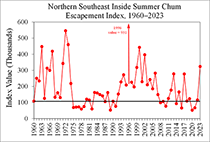
Figure 10. — Click for more Info
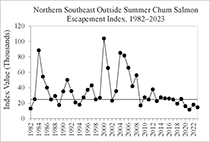
Figure 11. — Click for more Info
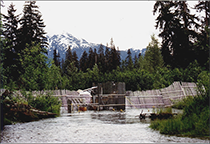
Figure 12. — Click for more Info
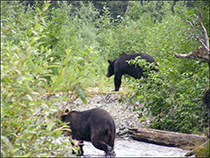
Figure 13. — Click for more Info

Figure 14. — Click for more Info

Figure 15. — Click for more Info
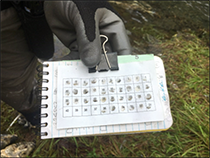
Figure 16. — Click for more Info
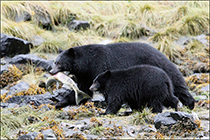
Figure 17. — Click for more Info
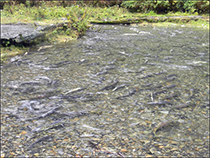
Figure 18. — Click for more Info
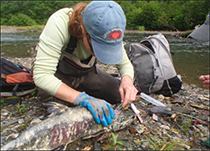
Figure 19. — Click for more Info
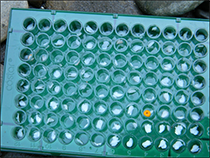
Figure 20. — Click for more Info
Introduction
Chum salmon (Oncorhynchus keta) are known to spawn in over 1,200 streams in Southeast Alaska (Figures 1 and 2). Chum salmon fry emigrate to the marine environment soon after emerging from the gravel in the late winter and spring, and then they typically spend two to four years at sea before returning to streams to spawn. Chum salmon populations in Southeast Alaska are generally divided into two runs based on migration timing: summer-run fish abundance peaks during the period from mid-July to mid-August and fall-run fish abundance peaks in September or later (Figure 3). Most summer-run chum salmon spawn in August and fall-run fish spawning peaks in late September and early October and continues well into the late fall or early winter in some systems. Chum salmon in Southeast Alaska weigh approximately eight to nine pounds on average (1969–2023), but average weights are variable from year to year (Figure 4).
Chum Salmon in Southeast Alaska Fisheries
Chum salmon are harvested primarily in commercial net fisheries and to a lesser extent by commercial troll fisheries, as well as sport, personal use, and subsistence fisheries. Annual commercial harvests of chum salmon in Southeast Alaska were historically at high levels in the early to mid-1900s, then gradually declined to their lowest levels in the late 1970s (Figure 5). The total harvest of chum salmon increased dramatically in the 1990s, including a peak total harvest of 16.0 million fish in 1996, and averaged 10.9 million fish since 1995. The common property harvest (total harvest minus hatchery cost recovery) of chum salmon during this same period averaged 7.5 million fish, and the total exvessel value of the harvest in the most recent 10-year period averaged $53 million a year—well ahead of the next most valuable species, pink salmon (O. gorbuscha), at $27 million a year.
Much of the increase in chum salmon harvest was due to the production of hatchery fish, which accounted for an average 88% of the commercial common property harvest of chum salmon over the past decade. Hatchery production of chum salmon in Southeast Alaska has increased substantially over the past four decades. In 1980, hatchery operators in Southeast Alaska released 8.7 million chum salmon fry at eight locations; by 2023, this number had risen to 607 million fry released at up to 23 locations (Figure 6 and 7).
Escapement Monitoring
Summer-run chum salmon are widely distributed in Southeast Alaska. There are 73 summer-run chum salmon index streams in the region and these streams were selected largely based on having consistent historical survey estimates. Summer-run chum salmon are most easily observed early in the season when there are fewer pink salmon present. It is often not possible to estimate numbers of chum salmon in streams that have substantial populations of pink salmon, and high pink salmon abundance in some years may mask chum salmon escapements in many areas. Of the chum salmon populations that are consistently monitored, most are monitored through aerial surveys, though many are also monitored by foot surveys.
Southeast Alaska summer-run chum salmon index streams are grouped into three stock groups that comprise aggregates of index streams across broad subregions. The Southern Southeast Subregion is comprised of 15 index streams located primarily on inner islands and the mainland from Sumner Strait south to Dixon Entrance (Districts 1–7; Figure 8). The Northern Southeast Inside Subregion includes 50 index streams located on inside waters north of Sumner Strait (Districts 8–12, 14–15, and District 13 subdistricts 51–59; Figure 8). The Northern Southeast Outside Subregion includes eight index streams located on the outside waters of Chichagof and Baranof islands in northern Southeast Alaska (District 13, excluding Peril Straits and Hoonah Sound subdistricts 51–59; Figures 8). Southeast Alaska fall-run chum salmon index streams are grouped into stocks that support, or have supported, terminal commercial fisheries in the past. These stocks are Cholmondeley Sound, Security Bay, Port Camden, Excursion Inlet, and the Chilkat River (Figure 8).
Summer-run Chum Salmon Escapement
Escapement indices for the Southern Southeast Subregion were low during the mid-1960s to late 1970s, increased into the 1990s, and have generally remained above the lower bound escapement goal over the past two decades, with the exception of poor escapement years from 2008 to 2010 (Figure 9). Escapement indices were above goal in nearly all recent years, and the escapement index of 276,000 fish in 2023 was a record high. Some of the largest summer-run chum escapements in this subregion are found in large mainland river systems east of Ketchikan, like the Tombstone River (Portland Canal), Keta River (Boca de Quadra), and the Wilson and Blossom Rivers (east Behm Canal). Numerous summer-run chum salmon streams are found on the islands of southern Southeast Alaska, with some of the largest escapements occurring at the Carroll (Revillagigedo Island) and Harris Rivers (Prince of Wales Island).
Escapement indices to the Northern Southeast Inside Subregion were generally high in the 1960s, and then declined in the 1970s and 1980s. The escapement index trended upward into the late 1990s, trended downward through 2010, and has fluctuated considerably since that time (Figure 10). The escapement index of 324,000 in 2023 was the largest index since 2002. Some of the largest summer-run chum escapements in this subregion are found on eastern Chichagof, eastern Baranof, and Admiralty Islands. Tenakee Inlet on Chichagof Island is an especially productive area and has numerous productive index streams like Seal Bay Head, Long Bay Head, West Bay Head, and Tenakee Inlet Head.
Escapement indices to the Northern Southeast Outside Subregion were variable but generally above goal from the early 1980s through 2008, but have been near or below goal in most recent years (Figure 11). Some of the most productive summer-run chum salmon streams in this subregion are the Black River and Sisters Lake Southeast Head (western Chichagof Island), and West Crawfish Northeast Arm Head and Whale Bay Great Arm Head (western Baranof Island).
Fall-run Chum Salmon Escapement
Fall-run chum salmon streams are not as numerous as summer-run systems in Southeast Alaska, but they are widespread and include the largest chum salmon run in the region at the Chilkat River. Fall-run chum salmon are often found in areas with abundant upwelling and more stable water temperatures that support development of overwintering eggs and fry. Due to the very late run timing of fall-run chum salmon, monitoring has been focused on systems that have had directed fisheries in the past. Other fall-run chum salmon runs likely experience very low harvest rates as most net fisheries end during the early stages of the fall chum salmon run.
Currently, formal escapement goals are in place for five fall-run stocks: Cholmondeley Sound, Security Bay, Port Camden, Excursion Inlet, and the Chilkat River. Escapement performance for fall-run chum salmon has been mixed over the past decade, with escapements at Cholmondeley Sound, Security Bay, and Chilkat River generally meeting goals in most years, including very large escapements in 2023. Escapements to Port Camden and Excursion River have generally been poor in recent years. There has been limited or no directed harvests of fall-run chum salmon for most of these stocks in recent years.
Historical Research Projects
Although there is currently little research being conducted on wild chum salmon in Southeast Alaska (beyond estimating escapement trends), a variety of chum-focused projects have operated over the past few decades. Some of the best information on harvest rates and distribution on a wild chum salmon stock in the region came from work done at Fish Creek-Hyder, located at the head of Portland Canal, from 1988 to 1995 (Figure 12), where chum salmon fry were implanted with coded wire tags and then recovered in commercial fisheries in Alaska and northern B.C. as returning adults. A calibrated foot survey escapement index was also developed at this time and annual foot surveys continue today to estimate chum salmon escapements at Fish Creek (Figure 13). A long history of research activity has also taken place at Disappearance Creek, a productive fall-run chum salmon system on Prince of Wales Island. Most recently, a weir was operated from 2008 to 2010, and efforts have been made to obtain age, sex, and length data from the run in many recent years (Figures 14–18). Age, sex, and length data has also been collected regularly from fish wheel projects on the Taku and Chilkat River in northern Southeast Alaska, and irregularly at other systems in the region. Finally, data on juvenile chum salmon abundance, early marine distribution, condition, and diet in northern Southeast Alaska is collected as part of the Southeast Coastal Monitoring Survey.
Hatchery Chum Salmon Straying
Chum salmon abundance in Southeast Alaska increased to historical high levels in the 1990s and 2000s, primarily due to increased production of hatchery chum salmon. While the hatchery program in Southeast Alaska provides major economic benefits to the region's commercial fisheries, it is also recognized that there are potential risks to wild stocks associated with large-scale hatchery production. The State of Alaska has numerous policies designed to minimize impacts of the salmon enhancement program on wild stocks, including a genetic policy, disease policies, a policy for the management of sustainable salmon fisheries, and a policy for management of mixed stock salmon fisheries, which gives the conservation of wild stocks, consistent with the sustained yield principle, the highest priority. Of particular concern is the possibility that hatchery-produced salmon might stray in large numbers to wild stock streams, with potential genetic, ecological, and management implications.
Since 2008, ADF&G has undertaken a tremendous amount of work to document the geographic extent of straying hatchery chum salmon in the region. This work included the creation of a science panel with members of ADF&G, University of Alaska, aquaculture associations, and the National Marine Fisheries Service. The science panel designed a long-term research project to answer key questions regarding the stock structure of chum salmon in the region, document the extent and variability in straying to wild stock systems (Figures 19 and 20), and the impact on fitness due to interactions between hatchery and wild chum salmon. Findings to date show that overall proportions of stray hatchery chum salmon in wild stock index streams regionwide is low, but most streams have some hatchery strays present and streams closer to release sites may have high proportions of stray hatchery fish. On a subregion basis, estimates of the proportion of stray hatchery chum salmon in escapement indices have ranged from 3% to 8% in the Southern Southeast Subregion, 2% to 13% in the Northern Southeast Inside Subregion, and <2% in the Northern Southeast Outside Subregion. New hatchery release sites in the Northern Southeast Outside and Northern Southeast Inside subregions since these studies were conducted have resulted in an increased number of stray hatchery fish, particularly in the Northern Southeast Outside Subregion where high proportions of stray hatchery fish from a new release site at Crawfish Inlet have been documented in a nearby index stream. Research focused on fitness impacts of stray hatchery chum salmon in Southeast Alaska is ongoing.
Selected Publications
- Chum salmon stock status and escapement goals in Southeast Alaska through 2019.
- Chum salmon stock status and escapement goals in Southeast Alaska through 2016.
- Chum salmon stock status and escapement goals in Southeast Alaska through 2013.
- Chum salmon stock status and escapement goals in Southeast Alaska through 2010.
- Chum salmon stock status and escapement goals in Southeast Alaska through 2008.
- Operational plan: Southeast Alaska chum salmon escapement index surveys 2019–2021
- Hatchery chum salmon contribution to southern Southeast Alaska commercial net fisheries, 2011–2015.
- Hatchery chum salmon contribution to southern Southeast Alaska commercial net fisheries, 2006–2010.
- Hatchery chum salmon straying in Southeast Alaska, 2011.
- Hatchery chum salmon straying studies in Southeast Alaska, 2008–2010.
- Proportions of Hatchery Fish in Escapements of Summer-Run Chum Salmon in Southeast Alaska, 2013–2015 — Josephson — 2021 — North American Journal of Fisheries Management — Wiley Online Library
- Disappearance Creek Chum Salmon Weir Study, 2010 (alaska.gov)
- Disappearance Creek chum salmon weir study, 2009. (alaska.gov)
- Disappearance Creek chum salmon weir study, 2008. (alaska.gov)
- Portland Canal Chum Salmon Coded-Wire-Tagging Project, 1988-1995 (alaska.gov)
